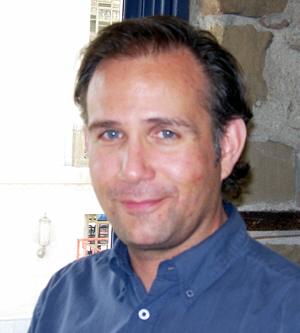1
There were also many television movies;
we make a lot of them in Canada for the major networks.
I’ve worked for all of them at one time or another.
They involve short, intense assignments, which are
excellent ways of learning the craft because you are in a
constantly changing environment. The
situations—every one is unique—force you to
figure out ways to make things work. That is the great
thing about my job, but it is also the bad thing about
it—you must constantly think about how you’re
going to accomplish what you must achieve.
I have also done a number of TV movies. I
did one ABC miniseries, DreamKeeper, as a second
assistant director, which aired over the course of two
nights in 2003. It was notable for me because it was
among the most difficult shows I have ever worked on. We
had to tell native stories set all over North America.
The logistics were demanding. We had to change tribes,
actors, locations; we had different everything—art
departments, for example—for each tribe.
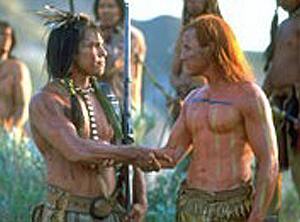
Scene from the 2003 Miniseries DreamKeeper
In the typical film, the start-up period
tends to be quite difficult because you are figuring how
everything is going to be done and how much time you are
going to take, but eventually, after the first week or
two, you are rolling and you have everything resolved.
But with DreamKeeper, once we would get settled,
we had to completely change everything. We had to
start-up all over, again and again. We had to move across
the province together. In fact, still, whenever people
who worked on DreamKeeper get together, we act
like veterans who fought in a war together. We invariably
end up telling stories about how difficult it all was!
Then there was Brokeback Mountain.
That is undoubtedly the highlight of all of the projects
I’ve worked on, and possibly of all of the projects
that I will ever work on.
How did you learn that Brokeback
Mountain was going to be made in Alberta?
From Tom Benz; he was the [unit]
production manager. I had just returned from Austria,
where I had been working on a production. As soon as I
arrived there was a message from Tom saying he wanted to
arrange an interview. I did not completely understand the
message, so I called him. He explained the situation: he
wanted to bring somebody in to be able to work with
Michael Hausman and Ang Lee so that some of their
knowledge and expertise would remain in the province
after the filming was completed. That would benefit the
film industry in Canada on another level, apart from the
economic advantages and the obvious notoriety associated
with having the film made in Alberta. I was interested,
but there were other candidates for the position as well.
2
So we arranged an interview. I was
slightly jet lagged when I showed up. I’d read the
script, which was phenomenal. That was when I realized
what I could be in for. The opportunity I was being
presented was incredible. I had done some other research.
Of course, I knew of Ang Lee, but I learned more about
Michael Hausman, Scott Ferguson [co-producer, and unit production
manager], and Diana Ossana. I immediately
recognized the caliber, significance, and quality of the
project before me.
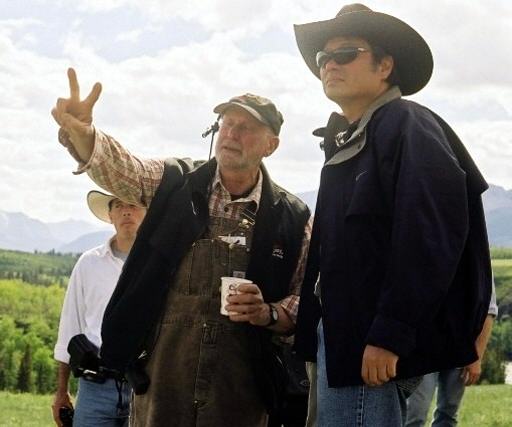
“I immediately recognized the caliber,
significance, and quality of the project before me.”
Rodrigo Prieto, Michael Hausman, and Ang Lee
Morley, AB
The interview itself was very
interesting. It’s difficult to describe. Michael
Hausman conducted the interview and it was very casual.
Tom Benz and Scott Ferguson were there. Ang Lee stopped
in to meet me; he was there for only a couple of minutes.
They made me feel at ease right away as they told me
about the project. They were very clear about what they
planned on doing.
I think the reason that I got the job was
that when they asked me if I had any questions, I asked
if they had an idea of what they wanted me to do on the
show. And they were not very clear about that, so they
asked me what I wanted to get from the show. I told them
I did not want to be what is known in the industry as a
“match,” that is, somebody that, under union
rules, they have to hire locally because they are
bringing in an outside person. I didn’t want to
simply show up, put in the time, leave, and pick up a
paycheck. I genuinely wanted to make a contribution. I
did not want to end up a match, which has happened on
other shows with other assistant directors I know.
3
The interview did not last very long,
maybe 20 minutes, and I went home and I told my wife, who
was, of course, very interested. I explained that they
were going to take a couple of days and that there were
other candidates. Tom had told me that they were planning
to discuss it among themselves and then they had to vet
their selection through the hierarchy. So I told her,
“We’re going to forget it ever happened.”
Then, about 20 minutes later I got a call from Tom Benz,
and he said, “They want you.”

“They want you.”
Unit Production Manager Tom Benz
I was overjoyed; an extremely happy day!
And then?
It was not very long; I think it was two
weeks. That just gave me enough time to become a little
more familiar with the script and the cast, and figure
out who was going to be involved. You never really know
when you go into these types of projects what your role
will be. You really can’t know unless you have
worked with everyone before. I did not know Michael
Hausman, Ang Lee, Scott Ferguson, or Michael Costigan [executive producer]at
all, and, since they were my direct supervisors, I
didn’t know what I was in for. It was “ to be
determined.”
I showed up on my first day and it was
then that I realized I was going to be very much involved
in the production. I was handed the script, and the
schedule, by Michael Hausman and was told to do the
breakdown, which is essentially taking the script and
putting it into its tiniest components—for instance,
specifying the trucks that are to be used—in a
program called Movie Magic, which is a computer program
that tracks all of that information regardless of where
you put them in the schedule, and it generates reports
that go to individual departments. Then, in my example,
there are meetings to determine exactly what kind of
trucks, to see what the art department can offer, discuss
the options, and find out what the director expects.
There are lots of meetings: truck meetings, art
meetings, stunt meetings, special effects meetings,
meetings within every department. Oftentimes more than
one department is involved.
4
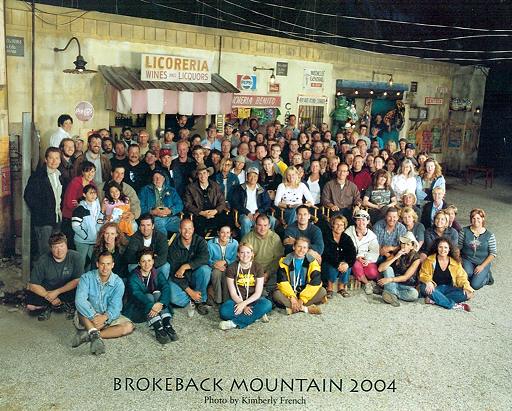
“Hell yes, we’ve been to Mexico!”
Brokeback Cast and Crew Photo Juarez
Alley Calgary, AB
I was given a big part in organizing
those meetings and making sure that everyone got their
time to raise and address issues. So I was very pleased
that from the get-go I was making a contribution. I
certainly wanted the education as well, which was also
great, because Michael Hausman made certain that I was in
his office for all of the high-level meetings with the
executives, actors, and agents. All of the high-level
meetings. I was invited to be a part of, not to
contribute to, but to be there and learn from a master of
film how decisions were made. And I appreciated it, and I
deeply appreciate it to this day. What I learned there
has had a profound influence on the way I do my job
today.
Both Lee and Hausman have had praise
for the professional expertise and craftsmanship they
encountered in Alberta.
Michael Hausman is an instructor at
Columbia [Columbia University, New York City], and I came
to realize that he is a natural born teacher. When you
meet someone who is a natural teacher, you instantly
recognize that they love to connect and share with young
people. That’s the way he is. He volunteered to put
on a master class, in fact he “coerced” Ang,
and Tom, Scott, and Diana, to come up with clips from
their projects. They brought them to a special seminar
and explained their importance, which was unprecedented.
5
Of course we have made many other films
here, but nobody has ever gone to the trouble of putting
on that kind of educational presentation for the film
community here. It was incredibly generous and so very
typical of his approach to filmmaking. So it was not just
us trying to please him. He made a point of giving
something back to the community. Very special.
With whom did you work most closely?
As an assistant director you have to work
with everyone; that is your job. But my direct supervisor
was Michael Hausman. Even though technically the
production manager would be my immediate supervisor,
there was never any question as to who ran that show. Michael
Hausman ran that show. And because of that,
everything, every decision, went through him. Of course,
creative decisions were made by Ang Lee, and script
decisions by Diana Ossana, but every decision went
through Michael Hausman, and the duties I had, everything
I did, came from him.
He made it very easy; he was very
encouraging and he was very generous in letting me do my
job. He could have quite easily made unilateral decisions
regarding just about everything, but he did not. He
always included the production team in those decisions.
He would gather us together and ask our opinions on
anything that came up, and it gave us a good feeling to
be able to contribute. He certainly didn’t have to
run things that way, but he did.
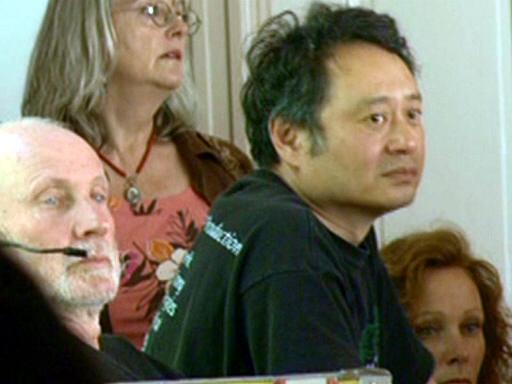
“Michael Hausman ran that show.”
Hausman and Lee Divorce Courtroom
Fort Macleod, AB
6
Can you capsulize what you learned
from working with Michael Hausman?
I think the most important lesson I
learned from Michael Hausman is that our position is
basically one of management. A film is a hard thing to
manage; it is, at best, an artistic endeavor. Especially Brokeback
Mountain, which is one of the purest artistic
endeavors I have ever been a part of. Management does not
just mean the schedule, or the paperwork, or being a good
communicator, or doing all of the basic things properly,
or being thorough. The most important thing about
management is that you are working with
people—producers, crew, cast, artists—and that
you need to hire people to do their best. People look to
leaders to be examples. If people respect who they are
working for, they will give their best.
Michael Hausman opened my eyes. Rather
than adopting authoritative style, he showed me a better
way to manage—by inspiration. That is the best way
to manage. If people are inspired, they will give you
their best. I believe to this day that you can actually
see the difference on the screen. I certainly know that
there are many films that are not run that way, but I
think that the ones that are made by inspiring the cast
and crew have a certain special quality, because people
give that extra bit.
I’ve known and worked with many of
the [Brokeback] crew members for years. Eventually
any crew will start to complain, after working for many
days, lots of long hours, God knows where, in awful
weather conditions. None of that necessarily shows up on
the screen, but it invariably happens. It’s only
natural for crews to grow weary and complain. In Brokeback
Mountain nobody complained.
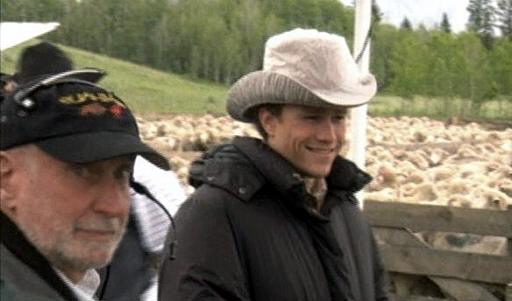
“In Brokeback Mountain nobody
complained.”
Michael Hausman with Heath Ledger Sheep
Staging Morley, AB
We have done many westerns here, all
sorts of westerns, but in this case there was a definite
realization that we were doing something important. There
was a sense that we were not part of some money-making
machine. We were not here for that. In fact, many of us
did not expect that the movie would make much money; we
thought we were making a contribution to film. As
pretentious as it may sound, we truly believed that we
were doing something artistically important. So there was
something more in our thoughts than just doing our jobs.
Michael Hausman made us feel like we were doing something
important. He was the best kind of leader. That’s
what I learned. Yes, I learned about leadership.
7
Ang Lee?
Because Michael Hausman was the producer
he was, Ang Lee left the non-artistic matters to him. Of
course, Michael always consulted with Ang, but Ang did
not have to worry about production issues because Michael
took care of them. And Michael always consulted with
others—Diana Ossana, Tom Benz, and so forth—in
making those decisions. He held meetings with everyone;
everyone was part of the effort.
That way, Ang Lee was able to concentrate
on performance, story, visuals—all of the things a
director should do. He didn’t get caught up on
production, technical, and budgetary things that tend to
be distracting.
Ang Lee was really very firm about what
he wanted. He was always quite clear about his
expectations, then he let Michael Hausman take the reins
as the guy out front. Michael “led the charge.”
Because Ang was so clear about what he wanted, I learned
that if you are doing your job as an assistant director,
the director won’t be distracted. If you do your
best as an assistant director, a good director will give
you his best. Ang Lee is the standard of what a good
director should be.
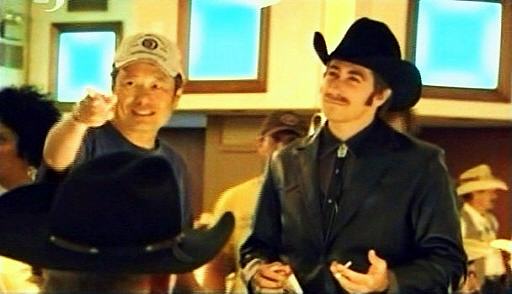
“Ang Lee was really very firm about what he
wanted.”
Childress Dance Hall Calgary, AB
I read that Ang Lee said in many films he
had to be a director who pulled people along, but in
making Brokeback Mountain he felt as if he was
being pushed along by the crew. There is some truth to
that. That is ultimately what you want to happen. It
speaks to him as a person, and as a professional, that we
wanted to do that for him; that we felt the desire to
support him, and his creative spirit, in every way.
8
Scott Ferguson?
Again, it was very educational to work
with him. I’ll tell you a story. When he first
handed me the schedule and started to talk about it, I
asked him questions. He did not have a copy of the
schedule in front of him. I asked questions about days I
thought might be too light, or too heavy, or where travel
between locations might pose problems. It was amazing; he
was discussing it without anything in front of him. He
had absolute knowledge of the material, a detailed
document some 20 pages long covering some 50 days of
shooting, hundreds of scenes, all across the province; it
was all in his head. And he knew it all cold.
And scheduling was just one of Scott
Ferguson’s enormous responsibilities. He worked with
Michael Hausman on the budget. Primarily the budget and
negotiating with the unions. He also negotiated with the
park authorities to get permission to bring domestic
sheep into the parks, which is completely illegal for
good reason. I don’t know if you are aware of this
but domestic sheep carry diseases that kill Rocky
Mountain sheep, and there were many long negotiations
over that issue. All of that was Scott’s
responsibility, along with Murray Ord, who is a local
producer. It was a challenge to get that access.
Scott’s ability to manage and retain
huge amounts of detailed information, and yet be an
incredibly personable guy, taught me that a great
production manager or assistant director should have
complete knowledge of the show. Scott had complete
knowledge of the show. Michael Hausman had complete
confidence in him, as he should. Scott Ferguson is among
the most capable production managers I have ever
encountered.
Diana Ossana?
First of all, she is a joy to work with. Brokeback
Mountain was not the first opportunity I had to work
with her; I had met her on a small miniseries that they
made here, Johnson County War. I had a smaller
role in that; I just helped with second unit.
Diana Ossana was so great in keeping us
focused on the story. I hope that we didn’t need too
much reminding, but that was her role. Whenever there was
a change that needed to be made it was done very smoothly
and, of course, the craftsmanship was unparalleled. I say
that not only from a creative perspective—she is a
superlative writer—but also from a production
standpoint. Pages came out in an efficient manner; she
has a good knowledge, an excellent knowledge, of
production.
Oftentimes there are problems in
production. You do not have access to a certain location,
or certain actors are not available; it happens. Some
writers do not understand the production implications of
what they are writing. They will respond to a problem by
writing something that makes a situation even worse. But
Diana is not like that. She has an excellent production
background so she will rewrite a scene that both makes
the story better and also helps production. We admire her
quite a bit around here. She is one of our favorite
people; I hope that she comes back.
9
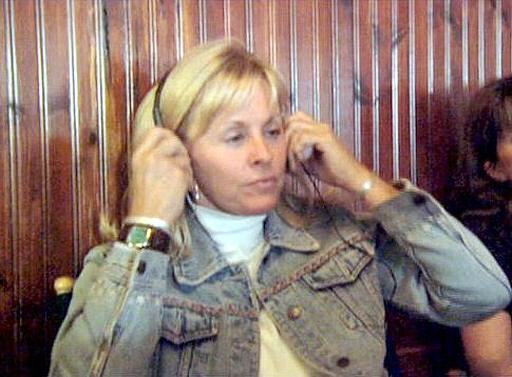
“She is a joy to work with.”
Diana Ossana at Cassie’s Bar Fort
Macleod, AB
Rodrigo Prieto?
He’s one of the finest people I have
ever worked with: a gentleman, incredibly talented,
soft-spoken, down to earth, approachable. You won’t
find anyone who will have anything other than the highest
praise for him as a person or as a cinematographer. What
else can I say?
You know the scene in the Mexican Alley,
which we teased him about—he was happy to do it! To
have that lack of ego and be willing to go to that extent
to make a contribution to the film, recognizing that he
had already made a massive contribution to the film, it
is astounding. He is a remarkable person in every way. I
wish he would come back to Alberta.
His technical knowledge is said to be
extensive.
You are right. To his credit, Rodrigo
Prieto has publically acknowledged the beauty of the
Alberta locations, but he did not give himself nearly
enough credit for the difficult job he had to do. There
were distinctive technical things about that film. So
much of it was shot outdoors, meaning that there were
different kinds of challenges involved than there are in
a film which is mostly made inside the studio. And there
are issues with natural light.
Natural light can be a very difficult
thing for a director of photography to deal with,
especially in the summer in Alberta. You may have noticed
how quickly the weather can change here. Of course, you
could be shooting a scene for a day, or two days, but you
must match the sky light for a scene which will be on the
screen for only a minute or two. So that becomes the
director of photography’s issue. The sun will be
passing through the sky, and I remember specifically that
we often encountered clouds. Inconsistent clouds.
10
Consistent clouds can be fine, because
they alleviate the problem of varying brightness and
shadows as the sun passes among the clouds. But,
unfortunately, we did not have those. The clouds would
pass in front of the sun, and I remember specifically
many times at the Goat Creek campsite [Campsite #2] when
we had to wait for clouds to shoot.
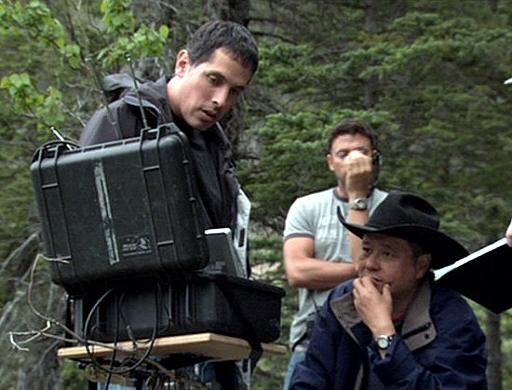
“A gentleman, incredibly talented, soft-spoken,
down to earth, approachable.”
Prieto with Lee at Campsite #2 Spray Valley
Provincial Park AB
Sometimes we would even do two versions,
one in the clouds and one in the sun. Then we’d wait
to see which version we had to match! That was very hard
on the actors because they had to sustain their
performances under both situations. And, at one point, we
were literally running between two different parts of a
scene, one we had established in clouds, the other we had
shot without clouds in sunlight. Fortunately, at that
point we were shooting with hand-held cameras, so when
the sun came out we would move to the sunny area, and
when it was in the clouds we would rush back to the other
area. It was the only way to move forward with our day.
This kind of thing is very tricky for the director of
photography, the actors, and the director. They all know
what they were doing.
Of course, clouds were not Rodrigo’s
only challenge. When we did the Mexican Alley scene,
which was very elaborate and extensively lit, he was able
to deal with the complexities of that as well!
11
[Script supervisor] Karen Bedard?
I love her; she is fantastic. Script
supervisor—that is a job for which there will never
be any kind of Academy Award, and there absolutely should
be one. A great script supervisor, or continuity person,
will save your keister several times in any movie,
because directors are not necessarily thinking about
continuity in a movie.
But a great script supervisor will also
point out continuity issues in story or performance, and
Karen is at that level; she is one of the top script
supervisors. Directors will trust her to tell them when
scenes might have some kind of incongruity. I am not
referring to just the physical elements, which of course
they will point out as well, but also how actors are
playing a story line.
I’ve known Karen for many years, and
she is incredibly respected by all of the directors for
whom she works, and she has worked with many of them
because they come from all over the world to shoot here.
She is a consummate pro.
Commentators have related the clothing
patterns and colors to themes in the story. Yet there is
nothing in the script itself about the clothing.
The people who were involved in that
decision were Marit Allen [costume designer] and Ang Lee.
Ang would probably inform the creative people, but they
would be the only people, other than the actors, of
course, who would know why they are wearing those colors.
I wouldn’t assume that those are all
conscious choices. It could be a case of people infusing
things into the film that are not there, though that does
not mean that it did not happen. This issue arises in all
artistic criticism. I was a student of film criticism
early in my career, until I realized that sometimes
people put too much faith in the filmmaker, crediting him
with incredibly deep decisions when really, much of the
time, what appears in the film is simply what looks best.
It may not have to do with the story, just that it looks
good.
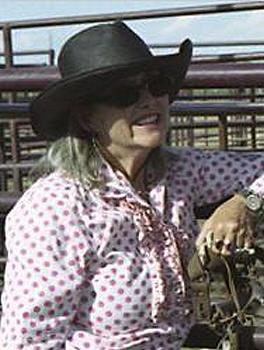
Brokeback Costume Designer Marit Allen
Childress Rodeo Rockyford, AB
That having been said, a director chooses
a color palette for the scenes in a film. The director,
the director of photography, the production designer, and
the costume designer all engage in very serious
discussions and decisions about colors. For instance,
Mexico obviously required a different color palette than,
say, the rodeo or the dance hall sequences. They are very
specific about choosing those colors, and, because Brokeback
Mountain is a movie of many individual frames, they
are very conscious of the ways in which colors are used
in those frames. You can never know with certainty, but
Ang Lee is a real artist. He may have gone that deep, but
I never heard any discussion about that.
12
|
